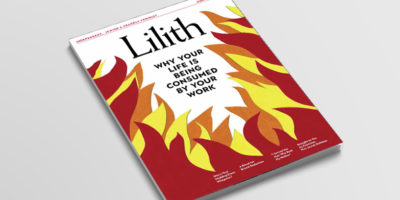Bringing Jewish Women’s History onto the Page
At a symposium honoring Lilith magazine, held at Brandeis University in March—before her new novel was published—Kadish (a Lilith intern a couple of decades ago) delivered remarks on, among other things, writing fiction. Here, an excerpt from her talk.
Jewish women on the screen, and many on the page, still aren’t given their full humanity. Too often they’re caricatures—shallow, materialistic, or controlling creatures, explored only one or two layers deep. The Jewish mother is still carved in the American literary psyche as Philip Roth’s mother. Comedian and actress Sarah Silverman has said, “I never get to play anyone who deserves love.”
But as more Jewish women write, the lives of Jewish women start to show up on the page in their full glory.
There’s so much work to be done to bring Jewish women’s lives and history onto the page—and so many stories yet to be discovered. For anyone as fascinated by history as I am, here’s a thought that will make you feel like you hit the jackpot: we have all of Jewish women’s history to explore.
In my novel, I wrote the story of a 17th century Sephardic Jewish woman who has an incandescent mind. Ester grows up in the same Amsterdam Portuguese-Jewish refugee community that excommunicated Spinoza—and like him, she’s drawn to asking the big questions. But as difficult and dangerous as it was for a Jewish man to pose those questions, it was more so for a woman.
Thinking about a fictitious woman in the very real and stark circumstances of women’s lives of that time, I asked myself: what could she do—what might she do—to keep mind and spirit alive?
She might, in this case, launch a deception. Ester and her brother are brought to London in the household of a blind rabbi. Her brother is meant to scribe for the rabbi, but when that fails, Ester is put in the role…and therefore given access to books and writing instruments that a woman would normally not have. And although she respects and loves the rabbi, she also treasures what she learned from him: that to ask questions is to be alive.
The rabbi is blind. And that means that if Ester is writing something other than what he dictates, or writing to a forbidden correspondent, he doesn’t know…
The novel, The Weight of Ink, opens in contemporary London, when a staircase is opened during the renovation of a 17th-century house and shelves of documents are found. The documents, which are written in Portuguese and Hebrew, are signed by an obscure 17th-century rabbi and initialed by an anonymous scribe. A historian—an English woman who has a complicated personal relationship to Jewish history—is called in to examine the documents, and she sees quickly that something about them doesn’t make sense. It’s she who discovers that the rabbi’s anonymous scribe was female…and she begins to chase down the well-hidden truth behind the pages left by a 17th-century Jewish woman.
A historical novel isn’t just about history, of course—it catapults us out of today and then back in, with a new perspective. This novel, though it’s partially set in the 17th century, is also about something I think about a great deal today: what it takes for a woman not to be defeated when everything around her is telling her to shut up and sit down. And about what can happen when women value and rescue each other’s stories.
We all know stories of brilliant, determined women, thwarted by their circumstances. And we also know glorious stories about what can happen when one voice breaks through and speaks the truth—whether in real life or in fiction. Bit by bit, we’re getting our stories onto paper. We’re depicting complex, real, sometimes thorny women—but unlike the caricatures we often see on TV, these are full human beings, people deserving of love.


